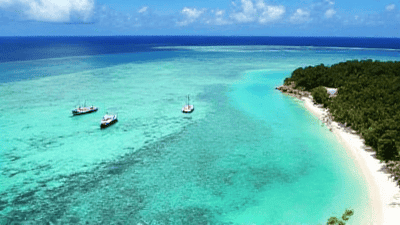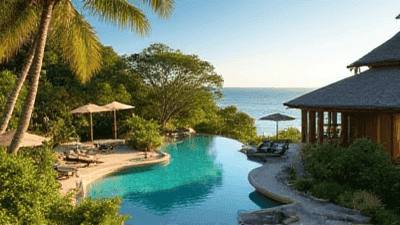
Tropical islands are often regarded as the ultimate getaway destinations. With their pristine beaches, crystal-clear waters, and lush landscapes, they offer a serene escape from the hustle and bustle of everyday life. For travelers seeking adventure, relaxation, and breathtaking beauty, island hopping is the perfect way to explore multiple islands while immersing yourself in a variety of cultures and experiences.
What is Island Hopping?
Island hopping refers to the practice of visiting multiple islands within a specific region, often utilizing various modes of transportation such as ferries, boats, or even small planes. This travel style allows visitors to experience diverse landscapes, activities, and cultures, all while enjoying the stunning natural beauty that tropical islands offer.
Why Choose Island Hopping?
Island hopping can be an exhilarating way to enhance your travel experience. Here are several reasons why you might consider this adventure:
-
Variety of Experiences: Each island has its unique charm, culture, and activities. By hopping from one island to another, you can enjoy a diverse range of experiences, from relaxing on secluded beaches to hiking in lush national parks.
-
Scenic Beauty: The journey between islands often provides stunning views of the ocean and surrounding landscapes. The allure of endless blue waters and panoramic sunsets makes the experience unforgettable.
-
Cultural Enrichment: Every island has its local traditions, cuisines, and communities. By visiting multiple islands, you have the opportunity to immerse yourself in different cultures and meet new people.
Planning Your Island Hopping Adventure
1. Choosing the Right Destination
Before you can start planning your island hopping adventure, you need to choose the right tropical destination. Here are some popular regions known for their island-hopping opportunities:
-
The Caribbean: With its numerous islands like Barbados, St. Lucia, and Antigua, the Caribbean is a top choice for tropical getaways. Each island offers a unique blend of culture and stunning natural beauty.
-
Southeast Asia: Destinations such as Thailand, Indonesia, and the Philippines boast stunning landscapes and vibrant cultures. Famous islands like Bali, Koh Samui, and Boracay are prime spots for an unforgettable island-hopping experience.
-
The South Pacific: Regions like French Polynesia and Fiji feature stunning lagoons and rich marine life. Islands like Bora Bora, Moorea, and the Yasawa Islands are ideal for adventure lovers.
-
The Mediterranean: While not tropical in the classic sense, islands like Santorini, Mykonos, and Capri offer breathtaking views and unique cultural experiences.
2. Selecting Your Islands
After choosing a destination, it’s time to select the islands you want to visit. Keep in mind the following factors:
-
Travel Time: Consider how long it will take to travel between islands. Some islands may be closer together, allowing for a more efficient itinerary.
-
Activities Offered: Research each island to determine what activities are available. Consider your interests, whether they involve water sports, hiking, or relaxation.
-
Cultural Experiences: Each island offers a different cultural experience. Look for islands with local festivals, markets, and traditions that interest you.
3. Planning Your Itinerary
Once you’ve selected your destination and islands, it’s time to plan your itinerary. Consider the following tips:
-
Duration on Each Island: Decide how many days you want to spend on each island. Balance your time between relaxation and activities to avoid feeling rushed.
-
Transportation: Research transportation options between islands. Look for ferries, boats, and domestic flights, as well as any schedules or booking requirements.
-
Accommodation: Find accommodation that suits your needs and budget. Options range from luxury resorts and beachfront hotels to hostels and vacation rentals.
4. Budgeting for Your Trip
Establishing a budget is crucial for any trip. Determine how much you can spend on transportation, accommodation, food, activities, and souvenirs. Here are some tips for budgeting:
-
Accommodation Costs: Research prices for different accommodation types and consider booking in advance for better rates.
-
Activity Costs: Factor in the costs of activities you want to participate in, such as snorkeling, diving, or guided tours.
-
Transportation Costs: Calculate the expenses related to traveling between islands, including any hidden fees associated with ferries or flights.
-
Dining Expenses: Eating out can significantly impact your budget. Research dining options on each island, including local markets or food stalls that offer affordable yet delicious meals.
5. Packing Tips
Packing for an island-hopping adventure requires careful consideration. Here are some essential items to include:
-
Lightweight Clothing: Tropical climates favor lightweight and breathable fabrics. Pack light clothing, swimwear, and cover-ups for beach days.
-
Comfortable Footwear: Bring sturdy sandals or flip-flops for the beach and comfortable walking shoes for exploring and hiking.
-
Sun Protection: Sunscreen, sunglasses, and a wide-brimmed hat are essential to protect yourself from the sun's rays.
-
Snorkeling Gear: If you plan to snorkel, consider bringing your gear to save rental costs.
-
Water Bottle: Staying hydrated is crucial, especially in tropical climates. A reusable water bottle is eco-friendly and can save you money.

Enjoying Your Island-Hopping Adventure
1. Engaging in Water Sports
One of the main attractions of island hopping is the numerous water sports available. Depending on the destination, you can enjoy snorkeling, scuba diving, paddleboarding, kayaking, and surfing. Research local providers for equipment rentals and guided tours.
2. Discovering Local Cuisine
Sampling local cuisine is an integral part of any travel experience. Embrace the opportunity to try traditional dishes and local specialties as you hop from island to island. Explore local markets and street food vendors for a more authentic culinary experience.
3. Interacting with Locals
Take the time to engage with the local communities you encounter. Learning about their cultures, traditions, and daily lives can enrich your travel experience. Attend local festivals, visit artisan markets, or participate in cultural workshops to foster genuine connections.
4. Exploring Nature
Each island boasts unique natural beauty, from stunning beaches to lush forests and mountains. Set aside time for hiking, snorkeling in coral reefs, or simply relaxing on the beach. Always follow local guidelines and practice responsible tourism to preserve these natural spaces.
5. Balancing Relaxation with Adventure
While the excitement of exploring new islands is thrilling, remember to take time for relaxation. Plan some downtime to lounge on the beach, read a book, or enjoy a massage. Striking a balance will ensure that you return home refreshed and rejuvenated.
Safety Considerations
1. Research Local Laws and Customs
Before traveling to different islands, familiarize yourself with local laws and customs. Understanding the cultural norms will help you navigate social situations respectfully.
2. Health Precautions
Check if any vaccinations or medications are necessary for your chosen destination. Additionally, pack a travel health kit with essentials like insect repellent, first aid supplies, and any personal medications.
3. Travel Insurance
Invest in comprehensive travel insurance that covers medical emergencies, trip cancellations, and lost belongings. Peace of mind can enhance your travel experience.
Conclusion
Island hopping can transform your travel experience, offering the chance to explore diverse cultures, breathtaking landscapes, and unforgettable adventures. By carefully planning your trip, budgeting effectively, and engaging with the local communities, you can create a remarkable tropical getaway that fulfills your wanderlust without breaking the bank. So pack your bags, embark on this adventure, and discover the magic of island hopping.



